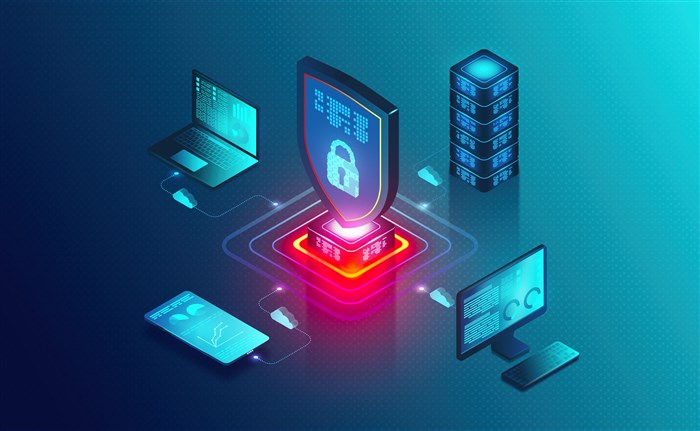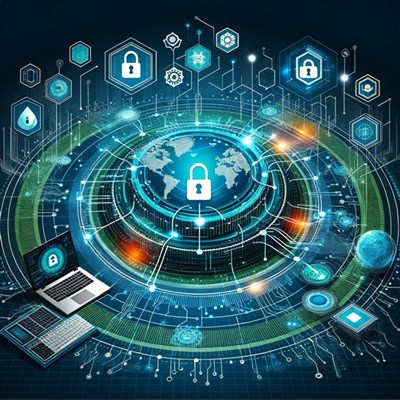
Cybersecurity is of the utmost importance in an era that thrives on technology. Cybersecurity protects all internet-connected systems, devices, and services from malicious cybercriminals.
We live in the digital era. Technology has permeated every part of our lives. Anything we need, we can find with a swipe of our finger. From advanced technologies, such as IoT, to the latest technologies, such as ChatGPT, technology has made our lives far simpler and more convenient. However, this convenience comes with its potential threats.
Behind every technology we use, there's a potential threat of cyber crimes. The latest cybercrime statistics are terrifying in that aspect. Cybersecurity Ventures estimates that the cost of cybercrime globally can reach $10.5 trillion by 2025. This has made cybersecurity all the more essential.
In this blog, we have discussed everything you need to know about cybersecurity, what it is, its importance, types, myths, the latest challenges, and domains. We have also covered the top cybersecurity certifications.
What is Cybersecurity?
In simple terms, cybersecurity is the protection and defense of devices, systems, and networks connected to the internet from malicious actors, such as cybercriminals and hackers. Cybersecurity primarily focuses on defending assets. However, some aspects focus on attacking first.
Organizations and individuals use cybersecurity to protect their data and systems from unauthorized access. A strong cybersecurity strategy can protect your assets from being accessed, altered, destroyed, or leaked. Often, cybercriminals do it to extort money from users or disrupt normal business processes.
Importance of Cybersecurity
Organizations all across the globe thrive on data. They gather and analyze the data of millions of users to develop products that meet the customers' needs. And so, even a single breach can lead to a data breach of millions of people. Most of this data is sensitive and can cause much damage to users. For example, the Yahoo data breach in August 2013 impacted the accounts of almost 3 billion people. As such, the importance of cybersecurity is unparalleled.
Data breaches lead to a loss of trust and faith from customers and a substantial financial impact on the organization. One may argue that technology is becoming increasingly sophisticated and can prevent these attacks. However, they forget that cybercriminals are also becoming more sophisticated and using subtler ways to attack. Therefore, cybersecurity is imperative. It is at the center of all organizations, whether small or big. The cybersecurity market is expected to grow to $266 billion by 2027 from $189.9 billion in 2023, making cybersecurity more necessary.
How does Cybersecurity work?
Cybersecurity is not just one tool or technology. It covers many technologies, processes, and methods that protect systems and data from attacks. How does cybersecurity work?
To answer this question, we will divide cybersecurity into different domains.
Application Security
Application security involves creating, adding, and testing security features in applications to prevent cyber attacks and make them secure. It primarily defends against threats during the app's development stage.
Information Security
Also called InfoSec, this domain protects all kinds of data from unauthorized access and prevents any changes, modifications, disclosures, and deletions. It protects sensitive business information and ensures data security.
Network Security
This involves protecting computer networks and network-accessible resources from unauthorized access and modifications. Network security combines strategies, technologies, and processes that protect a network from intrusion.
Disaster Recovery or Business Continuity Planning
This refers to developing preventive and recovery systems to manage and respond to potential cyber threats. It enables an organization to recover from unfortunate incidents and function quickly.
Cloud Security
Cloud security protects the cloud infrastructure, environment, applications, and data from threats. It ensures the authentication of end users and devices and provides data privacy protection.
Critical Infrastructure Security
Critical infrastructure security refers to protecting the infrastructure without which the security of a nation may be in danger. It consists of both cyber and physical systems crucial to ensuring cyber security.
Mobile Security
Mobile security protects mobiles, tablets, or laptops from any malicious threats of data loss or asset loss. With the popularity of mobile, it has become an essential part of cybersecurity.
End-User Education
As the saying goes, knowledge is power, and awareness is the key to reducing cyber crimes. Training employees and people about cybercrimes, and industry best practices and protecting themselves from threats like social engineering are incredibly important.
Types of Cyber Threats
There are several different types of cyber threats. Here are some of the most common ones.
-
Cyberterrorism: It refers to illegal threats and attacks against networks or data stored in systems. The intent is to coerce the owner (the government) for political or ideological objectives. It is meant to cause widespread social disruption.
-
Trojans: If you are familiar with the tale of the Trojan horse, you can deduce what a trojan does. A trojan misleads the users into believing that it's a harmless file. Once opened, it attacks the system and performs destructive action without you even realizing it.
-
Malware: Malware, or malicious software, includes spyware, worms, viruses, and ransomware. It is sent over a network and meant to infect, steal, or do anything the attacker wants. It can disrupt the system and even transfer sensitive data.
-
Phishing: A type of social engineering, phishing refers to deceiving people and getting them to share sensitive data. It typically happens over email. Phishing can also install malware in the system.
-
Botnets: Botnets, or robot networks, is a vicious cyberattack that involves a group of malware-infected computers controlled by a single cybercriminal. It is so harmful that all the infected computers become a part of the botnet system.
-
Denial of Service: DOS attacks involve disrupting the traffic of the target system with the help of multiple systems. Under this attack, the target system is overwhelmed with packets or connection requests to prevent it from being accessed by legitimate users.
-
Adware: Adware, or advertising-supported software, generates unwanted advertisements in the software's user interface. It is done without permission.
-
Man-in-the-middle attack: As the name suggests, this attack involves an attacker secretly intercepting and relaying messages between two parties. The two parties believe they are communicating with each other.
-
SQL Injection: A code injection technique, SQL injection can destroy your database. The attacker interferes with the queries an application is sending to its database.
-
Social Engineering: Social engineering attacks take benefits of human frailty. It tricks and misleads users into giving away sensitive information and bypassing security procedures.
-
Ransomware: A type of malware attack, ransomware involves locking the target's system files, mostly through encryption. The attacker demands a ransom in exchange for decrypting the system.
-
Advanced Persistent Threats (APTs): In this attack, the attacker can get unauthorized access to a system and stay there for a prolonged period without getting caught. The aim can be to steal sensitive data.
-
Insider threats: Insider threats are those initiated from inside the target organization. The insider uses their authorized access to harm or disrupt the organization's systems.
The list of cyber threats is long. However, these are the most common attacks employed by cybercriminals. Some other common cyber threats include cross-site scripting attacks, exploit kits, business email compromise, spear phishing, etc.
Benefits of Cybersecurity
After all that you've read about cybersecurity, it is clear that organizations cannot properly function without an excellent cybersecurity department. Here are a few other benefits of cybersecurity.
- It helps in the proper functioning of organizations by protecting them from any malicious cyber attack.
- Cybersecurity also strengthens the mitigation and response.
- Cybersecurity helps in making the recovery process faster and more efficient.
- Having brilliant cybersecurity inspires confidence in customers and stakeholders.
Myths of Cybersecurity
Cybersecurity is unfortunately shrouded in myths. This might be because of how hard it may look to someone not well-versed in technology. However, these myths can lead to dangerous situations.
Here are some of the most common myths about cybersecurity.
-
Password is enough protection: While there may have been a time when passwords provided enough security, it is no longer so. Strong passwords can provide some semblance of security, but it is not enough. It is imperative to create a multi-layer defense. You can start with multi-factor authentication.
-
Small and medium-sized businesses are not a target: Another popular myth is that only big corporations become the target of cyber attacks. However, the truth is that small and medium-sized business is at similar risks. In fact, a report by CyberPeace Foundation found that 43% of all cyberattacks target small and medium-sized enterprises.
-
Encryption is not worth it: Many organizations feel that encryption software is not worth it. However, it is a misconception. Encryption is a crucial part of cyber defense. It can protect you from ransomware attacks.
-
Deleting the file does the trick: Deleting a file, even from the recycle bin, is not enough because your computer just stores remains in the hard drive. Files can be easily recovered by using an easily available recovery software. Therefore, the best way to delete a file permanently is to use data-wiping software.
-
Data security is IT's concern: While IT departments hold the most responsibility in ensuring data safety, it is not only their concern. It is the responsibility of every member of the organization to ensure the safety of their data. Therefore, employees should regularly take part in cybersecurity awareness training to protect their data better.
Top Cybersecurity Challenges
Cybersecurity is full of challenges. As technology advances, so will cyber attackers. Organizations still need help to keep up with the latest developments. Some of the top cybersecurity challenges are as follows.
Evolving Threats
One of the cybersecurity industry's biggest challenges is the continuously evolving threats. Cybercriminals are constantly inventing new methods of attacking security. Organizations must keep up with the changes and update their cyber defenses accordingly to prevent accidents. This is especially difficult for smaller organizations that do not have a dedicated team of cybersecurity professionals.
Cybersecurity Awareness Training
Many cyber attack methods, such as social engineering, mislead people with access to launch attacks. Employees may accidentally allow threats in their work laptops or mobile devices by something as simple as downloading an attachment in an email. Therefore, it is imperative to organize cybersecurity awareness training for everyone. Regular training can help employees recognize possible threats and beware of them.
Workforce Shortage
Another major challenge to cybersecurity is the workforce shortage. The need for qualified cybersecurity professionals is rising as organizations become more technology-driven. The digital revolution has made even small businesses rely heavily on technology. According to (ISC)² Cybersecurity Workforce Study, the global cybersecurity workforce gap is 3.4 million.
Large Volume of Data
Organizations today leverage data to achieve their goals. However, the sheer volume of data can create problems. The more sensitive data an organization has, the more attractive it is to cybercriminals. This puts everyone whose data is stored within the organization at serious risk.
Who is a Cybersecurity Expert?
You already know the importance of cybersecurity. With cybercrime continuously rising, cybersecurity experts are in high demand across industries. As mentioned above, the workforce gap is 3.4 million globally, making this a lucrative profession.
Cybersecurity experts find, test, and repair vulnerabilities in the security infrastructure, monitor systems, identify breaches, strengthen cyber security, and install cyber defenses. To become a cybersecurity professional, you don't necessarily have to take the traditional way. You can get renowned certifications to prove your skills and knowledge in the field.
Certifications for Cybersecurity Professionals
Here are some of the most popular cybersecurity certifications.
Certified Information Systems Security Professional (CISSP)
One of the most sought-after certifications, CISSP is provided by(ISC)². This certification validates your skills in designing, implementing, and monitoring effective cybersecurity programs. This advanced-level certification is appropriate for people looking to advance their careers and take them to new heights.
The certification requires you to have at least five years of cumulative work experience in at least two of eight cybersecurity domains. The domains include
-
Identity and Access Management
-
Asset Security
-
Security and Risk Management
-
Security Assessment
-
Testing.
Certified Information Systems Auditor (CISA)
Provided by ISACA, CISA is another popular cybersecurity certification. It validates your skills in assessing vulnerabilities, and designing and implementing controls, among other things. It is an intermediate-level certification suitable for people wanting to advance their careers. It suits IT audit, compliance program managers, information security analysts, and IT project managers. The certification requires you to have at least five years of IT experience.
Certified Information Security Manager (CISM)
Another certification from ISACA, CISM, validates your knowledge in the management aspect of information security. It includes topics like risk management, governance, incident management, etc. It is suitable for individuals looking to transfer to the management aspect of security. People with CISM can apply for job roles like the director of information security, information risk consultant, and information systems security officer. The certification requires you to have at least five years of experience managing information security.
CompTIA Security+
If you are a beginner, CompTIA Security+ is ideal. It is an entry-level certification that covers the basic skills required for any cybersecurity professional. It covers topics like assessing organizations' security and monitoring and securing mobile or cloud environments. With this certification, you can apply for roles like help desk manager, cloud engineer, software developer, and systems administrator.
Certified Ethical Hacker (CEH)
The Certified Ethical Hacker is an intermediate-level certification. It teaches and validates your skills in identifying weaknesses in a system. Offered by EC Council, it is one of the most popular cybersecurity certifications. The course spans different topics, including hacking web servers, sniffing, cloud computing, surveillance, and cryptography.
CompTIA Advanced Security Practitioner (CASP+)
This advanced-level certification is suitable for people who want to continue their work in technology. The course includes software vulnerability, enterprise security domains, cryptography techniques, risk analysis, and securing cloud technologies, among other things. With this certification, you may be qualified for the roles of security engineer, vulnerability analyst, application security engineer, and software engineer.
GIAC Certified Incident Handler (GCIH)
GCIH is suitable for people working in incident response. It covers offensive operations, detecting and responding to attacks, and common attack techniques. This certification can help you get job roles like system administrator, security incident handler, etc. There are no official prerequisites for the certification.
Offensive Security Certified Professional (OSCP)
OSCP is provided by Offensive Security. It is an expert-level certification that covers skills such as using information-gathering techniques, conducting remote attacks, analyzing and modifying public exploit code, and writing basic scripts and tools. The certification requires you to be proficient in TCP/IP networking and Python scripting and have some experience with Linux and Windows administration.
Conclusion
In today's world, we cannot do without cybersecurity. From the blog, you can see the importance of cybersecurity. As technology becomes more integrated into our lives, cybersecurity will continue to rise in importance. Cybersecurity professionals will also be in high demand. Therefore, if you want to begin your career in this lucrative field, there is no time better than today.



(1).pngM.jpg)


.pngM.jpg)
COMMENT